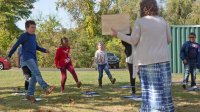The Role of Reciprocal Behaviors in Creating a Strong Community
Give-and-take is key in developing interpersonal bonds, but it can be tough for students. These activities foster this important social skill.
Your content has been saved!
Go to My Saved Content.An 8-year-old boy is routinely involved in incidents related to sharing. A seventh grader dominates every conversation she enters. And a high school sophomore refuses to join a small group for project-based learning. Each of these examples highlights a challenge with reciprocity.
Social reciprocity is a type of engagement that requires an element of give-and-take. It may involve back-and-forth sharing (of an object, thoughts, or actions) or participation in a mutually shared experience. These encounters, also referred to as “serve-and-return” interactions, are essential building blocks for brain development and social fluency. Think of serve-and-return as a game of ping-pong: One player sends the ball (the interaction) over the net and the other player sends it back.
Positive reciprocal behaviors don’t always come naturally. There are many reasons why students struggle with reciprocity, including developmental appropriateness and features of personality. For instance, students who prefer a high degree of order or are very competitive may find give-and-take more effortful.
Trauma-impacted learners are especially likely to face difficulty in this area. In fact, those with a history of adverse life experiences—including the events of the last year—are frequently challenged by reciprocity, an important indicator for resilience. Transition shock, including trauma, has the capacity to restructure neural networks in the brain—in some cases, the brain becomes less adept at quieting the amygdala, part of our body’s fight, flight, freeze, or submit response.
When we’re “stuck” in survival mode, we have less tolerance for trust, vulnerability, and ambiguity. We’re more likely to misperceive benign social cues as threatening ones. We may project internalized coping strategies (like irritability, aloofness, or self-defeating patterns) or externalized ones (such as physical or verbal aggressiveness or destructiveness). In any regard, it’s not exactly the kind of prosocial mojo that magnetizes others to us.
So the trauma-impacted person sends out a serve. It’s rejected, not returned. Over time, this exacerbates one’s coping mechanisms, leading to less prosocial behavior, and so on. The “persistent absence of serve-and-return interaction acts as a ‘double whammy’ for healthy development,” explains Harvard University’s Center on the Developing Child. “Not only does the brain not receive the positive stimulation it needs, but the body’s stress response is activated, flooding the developing brain with potentially harmful stress hormones.”
Fortunately, the brain is incredibly malleable, and research informs us that positive reciprocal behaviors can be explicitly taught and encouraged. We can embed serve-and-return practice into content area learning, language instruction, extracurricular activities, and structured play.
Reciprocal Behavior Strategies
Let’s explore five high-impact reciprocal behavior strategies that you can put to work today.
1. Emulation: Our earliest encounters with serve-and-return occur through mimicking (a father covers and uncovers his face and his infant daughter laughs). Early childhood education extensions of this include miming or expanded imitation (copying a movement and adding on a new one). Mimicking games like “Follow the Leader” or “Simon Says” can benefit middle-grade learners in a similar way. In upper-grade classrooms, improv activities like “What Are You Doing?” are an engaging way to embed emulation practice.
2. Object/Thought exchange: Who’s played “I Have, Who Has” with your students? Did you know you were promoting resilience as you played? It’s a great example of thought exchange. Reciprocity can be practiced with physical items, too. Two students might slide a car back and forth between each other as they ask and answer questions. A whole-class ball toss may be integrated into a vocabulary review. “Snowball Toss” is a powerful upper-grade lesson in reciprocity involving object exchange.
3. Shared experience: Purposeful presence in the same time and space as others fosters reciprocity. Here’s what this might look like for various grades:
- A class (kindergarten through second grade) baking a batch of cookies
- Two second graders partner reading a text
- A team of fifth graders mastering a TikTok challenge
- A committee of middle schoolers organizing the spring dance
- A high school English class creating and listening to a class playlist while working together, fundraising for a special field trip, or petitioning a law change
4. Shared expertise: Teaching others engages a world of reciprocal behaviors: gestures, facial expressions, questioning, clarifying, and (ideally) mutual acknowledgment and respect. A learner might share funds of knowledge about her cultural heritage or serve as a “buddy” to an incoming student. An early learner might exchange an important artifact with a partner for a short time, describing its meaning while allowing the other person to hold it and/or look at it. An older student might tutor young learners, act as a translator, or try their hand as an assistant basketball coach.
5. Modified reciprocity ring: The Reciprocity Ring was devised by Wayne and Cheryl Baker to increase corporate productivity (its roots are traced to the traditional Kula exchange of Papua New Guinea’s Trobriand Islanders). It can also be a valuable classroom tool. The activity invites participants to record a wish, goal, or need they have but would be challenged to achieve alone. Group members put their thinking, resources, and networks to work to collectively realize other participants’ ambitions. Reciprocity Rings teach students that there are many ways to give, and not all have to involve large amounts of time, money, or vulnerability.
Cognitive scientist Birgit Rauchbauer reminds us that “humans’ social bonds are established and maintained through interactions with others, [which] are characterized by intricate reciprocal relations.” Positive reciprocal behaviors, in turn, facilitate resilience. Resilience is something all students can benefit from, but that is particularly true for those with trauma histories, and is especially significant this school year and beyond.
